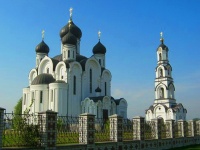- Home
- →
- Attractions
- →
- Cathedral of St. Fedorov in Pinsk
Cathedral of St. Fedorov in Pinsk
The St. Theodore Cathedral in Pinsk is one of the most important Orthodox churches in southern Belarus, a spiritual symbol of the city and a place of pilgrimage for believers and travelers alike. Rising to 33 meters in height, this impressive cathedral serves not only as a religious center but also as an architectural landmark. Seamlessly blending into the city’s skyline, it exemplifies the integration of traditional Orthodox architecture into the modern era.
History
The decision to build the cathedral was made in the late 1980s, during a period of spiritual revival and growing interest in national heritage. The construction was carried out through community effort, funded by donations from Pinsk residents, organizations, and local enterprises. Dedicated to St. Theodore Tyron, the heavenly patron of the city, the cathedral became a significant milestone in the modern history of Orthodoxy in the region. It was the first major church constructed in post-Soviet Belarus and marked a new chapter in the religious architecture of the Polesia region.
Architecture
The cathedral was designed by architect Leonid Makarevich in a retrospective Russian style, inspired by the work of Konstantin Thon — the creator of the Cathedral of Christ the Savior in Moscow. The building is a three-nave, three-apse structure with three entrances and five domes crowning its cuboid volume. The central dome, the tallest and largest, sets the vertical rhythm of the entire composition. The facades are adorned with pilasters, arches, and spherical elements, providing a strict yet expressive artistic character. Inside the cathedral, visitors can admire rich decorations, valuable icons, and frescoes created in the best traditions of church art.
Excursions
The St. Theodore Cathedral has become one of the key stops on many tours around Belarus, including itineraries that feature a tour from Minsk to Pinsk. Tourists and pilgrims visit to experience the spiritual atmosphere, appreciate the architecture, and explore one of the most prominent examples of new ecclesiastical construction in Belarus.


